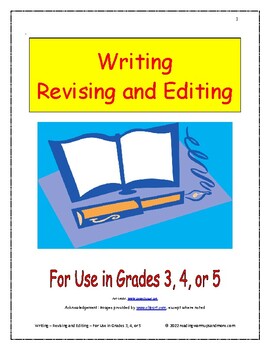Writing - Revising and Editing - For Use in Grades 3, 4, or 5
- PDF
What educators are saying
Description
Writing – Revising and Editing – For Use in Grades 3, 4, or 5
Writing – Revising and Editing – For Use in Grades 3, 4, or 5 is a series of short passages coupled with multiple choice questions that assess student knowledge and performance of revision and editing writing standards. This set of passages is for use with students in grades 3, 4, or 5. Students read a passage and answer questions based on the passage. The first five multiple-choice questions following each passage assess revising. This includes revising for clarity, organization, sentence usage, establishing a main idea, supporting sentences, and concluding sentences. The remaining multiple-choice questions assess editing. This includes writing conventions such as parts of speech, subject-predicate agreement, simple and compound sentences, capitalization, punctuation, and spelling. Both fiction and nonfiction passages are included.
Writing – Revising and Editing – For Use in Grades 3, 4, or 5 includes 36 passages with multiple choice questions. An answer key is provided along with a standards matrix displaying which questions in which passages cover which specific writing standards. A table of contents page is included that lists the name of each passage along with what kind of passage it is.
These practice passages can be used in a variety of ways. You may have your students read the passage and answer all of the questions in class. The answers can be checked and discussed immediately. You may have the students read the passages and answer only the first five questions that assess revising. You may also have the students read the passage and answer only the editing questions. The passages can be assigned as homework and checked in class the next day. Several passages can be put together as a mini-test. There are over 400 questions assessing the multitude of writing standards.
Writing Standards
Revising
1. Clarity
2. Main Idea
3. Supporting Sentences
4. Concluding Sentence
5. Language Patterns, Technical Aspects of Writing, Spelling
Editing
6. Parts of Speech – Verbs
7. Parts of Speech – Nouns
8. Parts of Speech – Adjectives
9. Parts of Speech – Adverbs
10. Parts of Speech – Prepositions
11. Parts of Speech – Pronouns
12. Parts of Speech – General
13. Parts of Speech – Transition Words
14. Subject and Predicate
15. Simple and Compound Sentences
16. Capitalization - General
17. Capitalization – Proper Nouns
18. Capitalization – Titles
19. Punctuation – General
20. Spelling – Plurals
21. Spelling – Double Consonants
22. Spelling – Silent Letters
23. Spelling – Base Words – Prefixes and Suffixes
24. Spelling – Homophones
25. Spelling - Patterns
Table of Contents
1. Nonfiction – Expository – “Plumbers”
2. Nonfiction – Report – “Field Day”
3. Nonfiction – Expository – “The Flag of the United States”
4. Fiction – Story – “Cooking”
5. Fiction – Journal – “Milking”
6. Nonfiction – Persuasive – “Organize Your Computer Now!”
7. Nonfiction – Expository – “Bugs”
8. Nonfiction – Expository – “The Armadillo”
9. Fiction – Story – “The Mystery Archer” .
10. Literary Nonfiction – Biography – “A Way West”
11. Nonfiction – Expository – “A Great Pride”
12. Fiction – Story – “Bowling”
13. Fiction – Story – “Blackberries”
14. Fiction – Story – “Bird”
15. Literary Nonfiction – Biography – “Davy Crockett”
16. Fiction – Story – “The Dragon”
17. Fiction – Story – “The Garage”
18. Fiction – Story – “Grandpa”
19. Literary Nonfiction – Autobiography – “I Am Sacagawea”
20. Nonfiction – Expository – “A Place Down Under”
21. Fiction – Story – “The Letter”
22. Nonfiction – Persuasive – “A New Shower!”
23. Fiction – Journal – “Camping”
24. Literary Nonfiction – Biography – “Sam Houston”
25. Nonfiction – Persuasive “Gas Too High?”
26. Nonfiction – Procedural – “Birdhouse”
27. Nonfiction – Expository – “Opposite Ends of the Earth”
28. Nonfiction – Expository – “Popcorn”
29. Nonfiction – Expository – “Pigs”
30. Nonfiction – Expository – “Castles”
31. Nonfiction – Procedural – “Lazy Summer Days”
32. Fiction – Story – “Neighbors”
33. Fiction – Story – “Morning”
34. Fiction – Story – “The Creek”
35. Nonfiction – Expository – “Money”
36. Literary Nonfiction – Biography – “Teddy Roosevelt”





